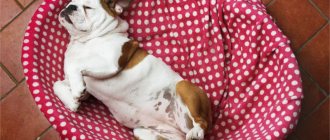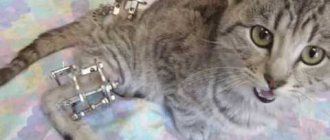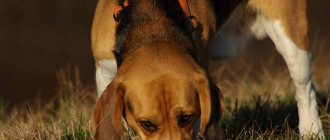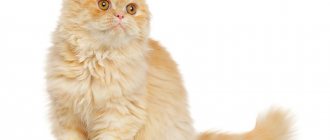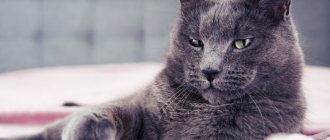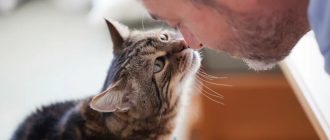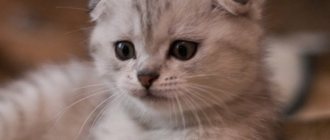The domestic cat is a proud descendant of wild and capricious animals, and claws are an important element of feline life: they help to hunt, defend themselves and mark their territory. The declawing procedure forever relieves the animal owner from hassle in matters of order and safety. In the article we examined in detail all the details of the operation. We will tell you why a cat is declawed, how the operation is performed, we will note the main points of caring for a cat after surgery, and we will outline possible complications.
What is “onychaetcomia”?
Onychectomy or soft paw surgery is an increasingly popular procedure, along with sterilization, as an alternative to conventional nail trimming for cats.
During onychectomy, the animal is completely deprived of its claws.
This surgery is performed by a veterinarian under general anesthesia. The doctor amputates the end whole phalanx of the fingers along with the claws. The procedure can be carried out through:
– removal of the nail plate with a scalpel and scissors;
– declawing using laser surgery;
The procedure is carried out under the supervision of a specialist
The operation is performed in a clinic, but there is also a home visit. In order to minimize pain, the animal is injected with an anesthetic, and additional medication may be given orally. The rehabilitation period can take a week and during this time the animal needs careful care.
Rehabilitation of cats after onychectomy
When the cat's claws are removed, the process of recovery after surgery begins, both for the condition of the paws and for the entire body. Fluffy needs the caring attitude of the owner.
There are a number of nuances for caring for a cat:
- pain relief in the form of injections, if necessary;
- daily treatment of wounds;
- the dressing needs to be changed regularly;
- A visit to the doctor is recommended once a week
.
The cat is really looking forward to its owner's love and care, only in this case it will get better sooner.
The recovery period after surgery lasts a month. During the first few days it is painful for the cat to stand on its paws; it will be hampered by pain and discomfort. Then the walking process gradually improves, but the cat may limp.
It is better to remove the cat's claws first on the front paws and then on the back paws. One by one deletion is allowed. This requires expert advice.
The meaning of claws in a cat’s life: “basic instinct”
Domestic cats and cats living their lives in apartment conditions are not quite the same as their wild ancestors. It is enough to turn to a simple example and draw an analogy with a private house: in the latter case, many owners allow the animal to spend time outside, and this significantly changes the essence of the issue.
What is the difference? Scratching is not just part of basic nail care. In nature, a domestic animal realizes its instincts: it hunts, snatches prey, climbs trees and, most importantly, marks its territory with the help of its claws, leaving the secretion of glands on the paw pads on the surface, thereby showing “who’s boss.”
All this allows the animal to maintain psychological balance and feel comfortable in the territory.
One of the strongest cat instincts is to mark its territory.
Alternatives
The overwhelming majority of cat lovers, felinologists and veterinarians are of the opinion that since cats are born with claws, they should remain with them. Some people believe that it is unnatural to remove a cat's claws to please the owner.
There are many arguments in support of this opinion. For example, the pain and suffering that pets go through, complications after surgery. Therefore, cat lovers and veterinarians look at this procedure as a last resort. But if owners want to give up their cats, euthanize them, or kick them outside due to the damage caused by claws, then cat onychectomy is an option to prevent this.
There are alternatives to declawing. One of them is teaching your pet to sharpen its claws in a designated place (on a scratching post or a specially covered board with hard fabric). This is a very effective method, but less successful when living with older cats.
There are also vinyl, rubber and silicone cat claw caps (set of 20). The service life of the caps is 1.5-2 months. They are put on using surgical glue, and cats usually get used to them within a day or two. But the glue must be applied correctly to the trimmed claws.
Owners sometimes glue several fingers together when they try to do this procedure themselves. Therefore, entrust the labeling of the caps to a professional who can also select the correct size.
Important! If your cat goes outside, the lifespan of the caps will be significantly reduced.
Trimming claws is also an alternative to removing them. If you do this weekly, it will solve the problem of people scratching, but it will not stop your cat from damaging the furniture. In addition, she will want to sharpen her trimmed claws more often.
Reasons for declawing cats
Recently, onychectomy has gained popularity among owners of absolutely healthy cats, ceasing to be an exclusively therapeutic measure.
The most common reason for the decision to remove claws is the animal's disobedience and hyperactivity, which results in significant damage to property. The decoration and furniture take on an unsightly appearance, requiring large financial investments and repairs.
Claws help a cat quickly adapt to its surroundings
Unfortunately, another reason lies in the individuality of each pet: some animals can show both innate and acquired aggression, scratching guests and even the owners themselves. Sometimes this happens unexpectedly, and owners cannot understand for a long time the reasons for the sudden change in the animal’s behavior. The situation becomes much more complicated if there are children in the family, who will always attract the pet’s attention with their movements.
Considering the situation irreparable, animal owners turn to the veterinarian.
Reviews
Statisticians conducted a survey of owners of animals that had their claws removed. The result showed: 76% of people regret doing this and 24% responded positively that the cat walks without claws. Veterinarians, 100%, are against onychectomy:
- If the operation is carried out only on the basis of the owner’s wishes, they consider it a mockery of the animal, comparing it with the amputation of a person’s fingers;
- frequent serious consequences - unjustified risk;
- Many veterinary surgeons, unless there is a medical indication, do not agree to perform such an operation.
When is declawing necessary?
Initially, onychectomy appeared for completely different purposes and was justified by serious medical indications.
A serious reason for declawing is:
– a complex chronic disease in a cat (epilepsy: the animal can tear out tufts of fur with its claws and injure itself);
– if the cat suffers from an infectious disease that is transmitted by scratching;
– deformation of the phalanges, which causes the animal severe pain when moving;
– if an adult animal began to show unreasonable aggression and the owners were unable to establish the reason for such behavior;
– the owner or family members have complex immunological diseases and blood diseases (for example: blood incoagulability, diabetes);
Declawing can have unpredictable effects on your pet.
IMPORTANT: other causes have many alternatives and do not require radical intervention!
Pros
The Soft Paws procedure does not benefit cats; declawing only benefits owners. Without the main weapon, the ability to mark territory by tearing wallpaper, flooring, and furniture is lost. The claws do not cling to clothes, do not accidentally dig into the legs or shoulder when you take Murka in your arms or sit him on your knees.
Removal of the phalanges is resorted to before the birth of a child or shortly after the birth of the baby. Parents are worried that the pet will cause injury to the newborn. Onychectomy is considered when children perceive a pet as a toy - this is easier than a long explanation of why you can’t pull a cat’s whiskers.
The advantage of declawing is the prevention of many diseases - herpes, toxoplasmosis, chlamydia, fungal infections. This is on par with the myth of warts after contact with a toad. If you delve into the topic, the absurdity is obvious. But many believe unconditionally, ignoring scientific arguments.
For example, cat scratch fever is a Bartonella infection. The bacteria are found in the saliva, urine, tear fluid and other secretions of the carrier cat. For a person to get sick, he must have low immunity. But a scratch is not necessary - bacteria still enter the bloodstream through microcracks in the skin.
At what age can a cat be declawed?
The age of onychectomy is the most common question that worries owners who have decided to undergo surgery. Is it possible to have surgery at an early age?
You should refrain from performing surgery on a kitten: their claws do no harm. The body is just developing and it is not worth exposing the animal to serious stress. A kitten's young age is the right time to take steps to develop positive habits in your pet's character.
Nail trimming is a safe alternative for a healthy cat
The operation to remove claws is carried out after 7 months: the cardiovascular system has already become stronger, and the animal adapts more easily to the consequences of walking without claws. All medical interventions are much easier to tolerate at a young age.
Advantages and disadvantages of soft paw surgery
If owners don't know how to protect themselves and their furniture from scratches, it's important to learn the pros and cons of cat declawing. Depending on this, you can make the right decision regarding the operation. Benefits of declawing:
- The pet will no longer scratch household members and damage furniture.
- If the claws are pulled out, there will be no need to install scratching posts indoors.
- With the right rehabilitation process, the animal will be able to return to normal life within a week.
Disadvantages of surgical removal:
- The stressful situation of the animal after surgery can disrupt the usual lifestyle of all household members.
- There is a high risk of developing various complications after surgery.
- The cat will begin to learn to walk again.
- An animal without claws will not survive on the street.
There are many more disadvantages to this procedure than advantages. Therefore, you need to weigh the pros and cons.
How is declawing surgery performed?
The four-legged patient is prescribed a number of diagnostic procedures necessary to assess the risks to his life that may be caused by the anesthesia used during the operation.
Mandatory diagnostics of your pet’s health will protect you from unexpected complications.
After a complete examination, the doctor determines the possibility of surgery and sets a time for the procedure. Some owners are inclined to carry out onychectomy at home, hoping that the animal will better tolerate the operation in its own home. It is much safer if the intervention is carried out in a clinic in case of unforeseen circumstances that may require a quick response in a hospital setting.
The traditional method (scalpel, surgical scissors) is strict adherence to the “fasting regime” 8-12 hours before the start of manipulations and limiting any stress. Next, the doctor administers an anesthetic drug, after which the animal falls asleep. The surgeon removes the claws and sutures the affected surface; to relieve pain, the area is treated with an anesthetic and the paw is bandaged. A special “Elizabethan” collar is placed on the cat’s neck, which limits access to the limb.
The use of a laser repeats the scenario of the previous method, with the exception of excision of tissue with a high-intensity beam and is distinguished by the “purity” of the declawing procedure. Blood loss with this method of declawing is minimal.
Positive aspects of onychectomy:
– if there are serious medical indications, the animal will be relieved of discomfort and pain;
– the pet will not be a threat to your property;
– an aggressive disposition will not leave scratches on guests and the owner;
– it will be possible to allow children near the wayward pet and not be afraid of unexpected consequences;
The absence of claws eliminates the risk of injury when playing with an animal
Disadvantages of onychectomy:
– negative reaction to anesthesia;
– improper pruning: in this case, the phalanx may grow and the claw will grow inward rather than outward;
– onychectomy can greatly affect the character of the animal, making it passive or even more aggressive;
– declawing comes with many risks (tissue infection, poor mobility, etc.);
– during the rehabilitation period the animal experiences severe pain;
– during the recovery period, the cat will not be able to move independently;
– there is a possibility of large blood loss;
– development of arthritis as a consequence of further emphasis only on the pads of the paws;
Declawing leaves an animal defenseless
Legality
Cosmetic veterinary surgery is popular in the United States - animals have ligaments cut, piercings, and implants inserted. But even in their historical homeland, the “Soft Paws” procedure is abandoned due to the negative impact on health and quality of life. Declawing without indication has already been banned in 12 states.
In European countries, onychectomy without medical indications has long been prohibited; it is considered intentional mutilation. This is not a subjective attitude, but a legal definition of the essence of the process. A complete ban applies in the following countries:
- Great Britain
- Netherlands
- Germany
- Denmark
- Sweden
- Finland
- Norway
- Australia
- Israel
- Brazil
- Portugal
- Czech
- Serbia
- Belgium
- France
- Italy
- Spain
- Ireland
In Russia, a project to ban euthanasia, cupping and onychectomy without indications is under development. It will complement the already adopted Responsible Animal Welfare Act. Many breeders stipulate a ban on the removal of phalanges in the sales contract, but it is difficult to track its implementation. About a third of Russian clinics do not provide this service.
Rehabilitation period
The recovery period depends on the quality of the work performed, the professionalism of the veterinarian and the cat’s reaction to the operation.
A high-quality procedure is the key to a quick recovery
Immediately after the procedure, the cat will sleep: do not be alarmed, the animal may pee under itself and this is a normal reaction to anesthesia.
For the first few days, your pet will not be able to walk: he will be bothered by pain in his paws, joints and back. Use an Elizabethan collar and do not allow your pet to touch the bandages. Every day it is necessary to treat the seams and make sure that the cat does not lick them. Walking outside is completely excluded during this period: there is a high probability of infection of the affected tissues.
IMPORTANT: place the tray, bowl and bed as close to each other as possible, thereby reducing the distances your pet will have to travel!
Alternative Methods
Veterinarians do not recommend declawing without good reason.
Instead, they offer many alternative solutions to this issue:
- The easiest way is to teach a kitten to use a scratching post from the first days of being in the house. A well-mannered cat will never intentionally damage property.
- Follow hygiene procedures. Trim the claws with special scissors for cats.
- Buy protective attachments - silicone claws that are glued to the claws without interfering with the work of the claws and without causing discomfort to the animal.
We will be glad if you like our advice on gentle measures to combat sharp claws. It is much worse to repent of what you have done after you have made a decision.
Consequences, risks and complications
The psychological consequences can be unpredictable: adapting to a new lifestyle and experiencing severe stress, the animal can become irritable, withdrawn, and aggressive. Having lost a vital organ, a pet may perceive this as a danger and begin to avoid people. The situation is fraught with problems with going to the litter box: the cat may lose interest in the box due to the inability to “bury” the filler.
Possible physical effects, risks and complications include:
– prolonged and severe pain, inability and discomfort;
– deterioration of condition after anesthesia;
– violation of coordination and functions of the vestibular apparatus: the center of gravity shifts to the entire paw;
– osteomyelitis: inflammatory infectious disease of the bones;
– curvature of the spine, joint diseases;
– risk of developing an inflammatory infectious process;
Advantages and disadvantages
The only advantage of onychectomy is that it frees the animal from the habit of scratching and spoiling things. If the nail is pulled out for medical reasons, the pet may be able to get rid of the disease that became the main reason for the operation. However, often pulling out claws is harmful to your pet's health. The disadvantages of the technique are:
- forever lost health of a four-legged friend;
- psychological trauma;
- a radical change in the habits and character of a cat or kitten;
- the animal's defenselessness against dangerous external factors;
- long period of rehabilitation and recovery;
- high cost of the operation itself.
Operation price
If you decide to have an onychectomy, you should not save money. You should entrust the operation to a highly qualified specialist and a veterinary clinic, where your pet will be provided with proper attention.
Entrust the procedure to a highly qualified veterinarian, find out about the experience of performing similar operations
The price for the service is 50-70 dollars. Laser declawing is performed in few clinics and costs approximately $150.
Cost of the “soft paws” procedure
The price is affected by the level of services and location of the medical institution. Moscow clinics ask for 2-5 thousand rubles. for such an operation. In remote centers the cost is reduced to 1 thousand. Due to the complexity of the operation, it is worth choosing a specialized clinic, or better yet, where the doctor comes to the cat’s home. Such a call will cost more, but the pet will recover faster.
Another reason for contacting a specialized institution is the reliability and honesty of the staff. Now that few people undertake onychectomy, there are many advertisements with false promises.
For unfortunate surgeons, the main thing is money, not caring for the animal. Often operations based on such advertisements are carried out without following the correct technology and in violation of sterility. Such assistance, when inflammation begins, sometimes ends in amputation of the paw.
A cat's claws are vital
